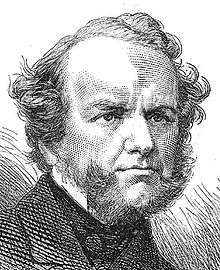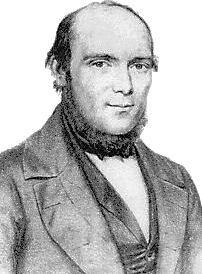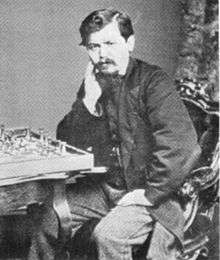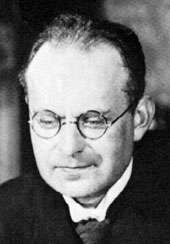School of chess
A school of chess means a chess player or group of players that share common ideas about the strategy of the game. There have been several schools in the history of modern chess. Today there is less dependence on schools – players draw on many sources and play according to their personal style.
Philidor

In 1749, François-André Danican Philidor published Analyse du jeu des Échecs. This was the first book to discuss the strategy of chess in the whole in detail. It was also the first to discuss the interplay of pieces and pawns in the game. Philidor believed that maintaining the mobility of pawns was the most important strategic factor of chess, and he discussed pawn structure, particularly isolated pawns, doubled pawns, and backward pawns.
Philidor's writings were widely praised and often misunderstood for 90 years. His ideas were taken up by the English school in the 1840s. In 1925 Aron Nimzowitsch recognized the importance of pawn mobility. Philidor has increasingly been recognized as the founder of modern chess strategy.
Modenese school
The Modenese school is due to three 18th-century players known as the Modenese Masters: Domenico Lorenzo Ponziani, Giambattista Lolli, and Ercole del Rio. They recommended playing the Italian Game opening. In contrast to Philidor's idea of pawn structure and mobility, the Modenese school emphasized rapid development of the pieces for an attack on the opposing king, aiming for checkmate or winning material in the process. This style of play was used by Gioachino Greco, Alessandro Salvio, and other Italian players of the 16th century (Sunnucks 1970:309–10).
English school

The English school was founded by Howard Staunton in the 1840s. His followers included Bernhard Horwitz, Elijah Williams, Marmaduke Wyvill, and to some degree Adolf Anderssen and Daniel Harrwitz. In this style, there was no quick attack on the opposing king. Instead, the position was prepared – control was gained over the center and key points. Attacks came only after strategic advantages were obtained. Pieces were developed behind pawns to support their advance. Staunton pioneered the use of flank openings and the fianchetto of the bishop. After Staunton practically retired in 1853, these ideas were neglected.
Romantic chess

Romantic chess was the style of chess prevalent in the 19th century. It was characterized by brash sacrifices and open, tactical games. Winning was secondary to winning with style, so much, in fact, that it was considered unsportsmanly to decline a gambit (the sacrifice of a pawn or piece to obtain an attack). It is no coincidence that the most popular openings played by the Romantics were the King's Gambit Accepted and the Evans Gambit Accepted. Some of the major players of the Romantic era were Adolf Anderssen, Paul Morphy and Henry Blackburne. A famous game of this time is the Immortal Game between Anderssen and Lionel Kieseritzky. The Romantic style was effectively ended on the highest level by Wilhelm Steinitz, who, with his more positional approach, crushed all of his contemporaries and ushered in the modern age of chess.
Classical school

Around 1860 Louis Paulsen realized that many attacks on the king succeeded because of poor defense. Wilhelm Steinitz agreed with that and rejected the prevailing notion that attack was more honorable than defense. Steinitz strengthened defensive techniques and advocated strategic maneuvering to gain enough of an advantage before launching an attack. Steinitz was an advocate of the queenside pawn majority and the use of the bishop pair. He also emphasized occupation of the center of the chessboard and pawn structure. Steinitz began using his ideas in games in 1872. Steinitz had few followers at first, but by the 1890s most masters had been influenced by his ideas. Siegbert Tarrasch was a great promoter of the Steinitz school.
Hypermodern school

The hypermodern school was founded by Aron Nimzowitsch, Richard Réti, Savielly Tartakower, Gyula Breyer, and Ernst Grünfeld in the 1920s (Averbakh 2012:81). The hypermodernists rejected the idea that occupation of the center was important. Instead, the hypermodern school emphasizes control of the center by attacking it with pieces especially from the periphery. The hypermodern school also denied the superiority of the two bishops in all types of positions and claimed that the bishop pair was only strong in open or semi-open positions [1] (Averbakh 2012:81).
Soviet hegemony

In the 1940s the Soviet Union began a long domination of chess. The Soviet school agreed with Tarrasch and emphasized mobility. A weakness that could not be attacked was not a real weakness. The Soviet school was based on teachings of Mikhail Chigorin (1850-1908).
See also
References
- ↑ Aron Nimzowitsch, My System
- Averbakh, Yuri (2012), A History of Chess from Chaturanga to the Present Day, Russell Enterprises, ISBN 978-1-936490-44-8
- Hooper, David; Whyld, Kenneth (1992), "schools of chess", The Oxford Companion to Chess (2nd ed.), Oxford University Press, ISBN 0-19-280049-3
- Sunnucks, Anne (1970), "Modenese masters", The Encyclopaedia of Chess, St. Martins Press, ISBN 978-0-7091-4697-1